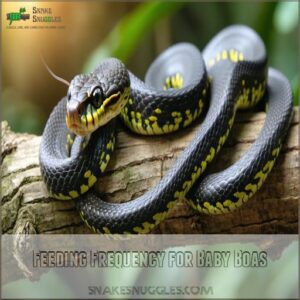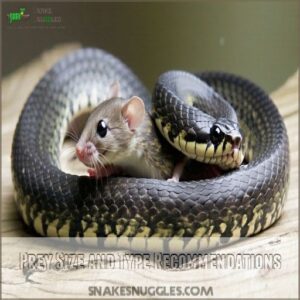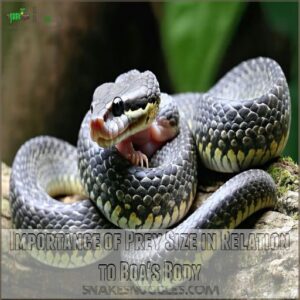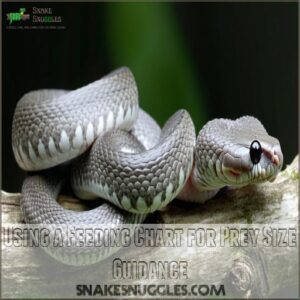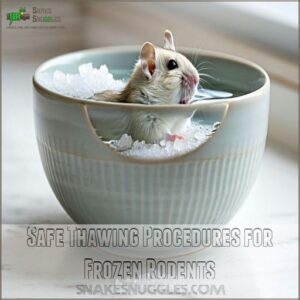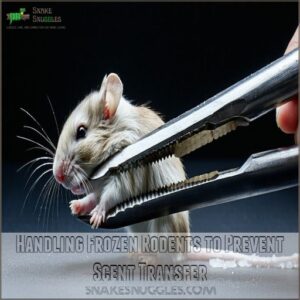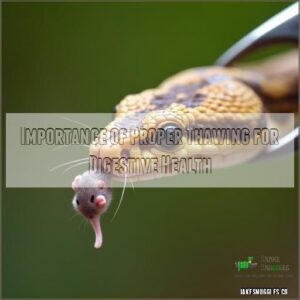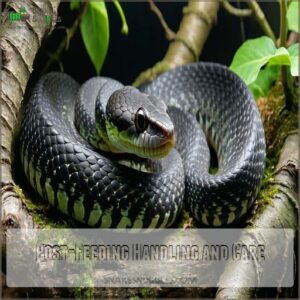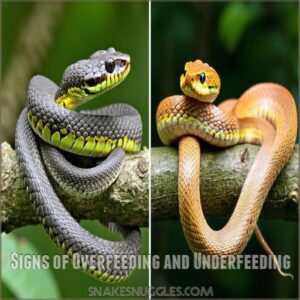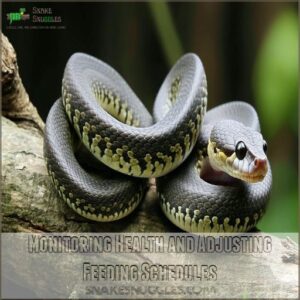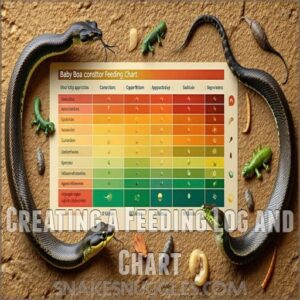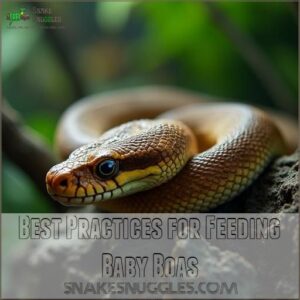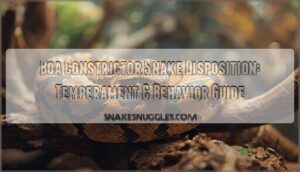This site is supported by our readers. We may earn a commission, at no cost to you, if you purchase through links.
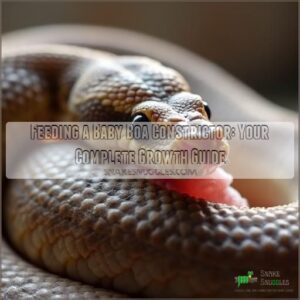 Feeding a baby boa constrictor is straightforward once you get the hang of it. Offer appropriately sized prey—something slightly smaller than the snake’s widest part—every 7 to 10 days.
Feeding a baby boa constrictor is straightforward once you get the hang of it. Offer appropriately sized prey—something slightly smaller than the snake’s widest part—every 7 to 10 days.
Frozen-thawed mice or small rats work best. Thaw the prey safely in warm water (never microwave it!) and use tongs to avoid accidental bites.
Keep handling to a minimum for 48 hours afterward to let digestion run smoothly.
Watch for signs of underfeeding, like a visible spine, or overfeeding, like excess fat. Baby boas thrive with consistency, so maintain a feeding schedule and monitor their growth—adjusting as they mature is key! Feeding schedule and prey size are important. Signs of overfeeding or underfeeding should also be monitored.
Table Of Contents
- Key Takeaways
- Feeding Frequency for Baby Boas
- Choosing The Right Prey for Baby Boas
- Thawing and Handling Frozen Rodents
- Post-Feeding Handling and Care
- Signs of Overfeeding and Underfeeding
- Monitoring Health and Adjusting Feeding Schedules
- Importance of Veterinary Care
- Creating a Feeding Log and Chart
- Factors Influencing Feeding Habits
- Best Practices for Feeding Baby Boas
- Frequently Asked Questions (FAQs)
- How long can a baby boa go without eating?
- How do boa constrictors take care of their babies?
- Why is my baby boa not eating?
- How often do you feed a yearling boa?
- What temperature should the boas enclosure be?
- How do I introduce new prey items?
- What if the boa refuses to eat?
- Can baby boas eat live prey safely?
- How does shedding affect feeding behavior?
- Conclusion
Key Takeaways
- Keep a consistent feeding schedule, offering appropriately sized frozen-thawed rodents every 7–10 days to match the boa’s body width.
- Properly thaw prey in warm water and use tongs to minimize risks, ensuring safe and hygienic feeding.
- Avoid handling your boa for at least 48 hours after feeding to support digestion and reduce stress or regurgitation risks.
- Monitor your boa’s body condition, looking out for signs of overfeeding (excess fat) or underfeeding (visible spine), and adjust feeding size or frequency as needed.
Feeding Frequency for Baby Boas
When you’re raising a baby boa constrictor, understanding its feeding frequency is vital for healthy growth and development.
You’ll want to establish a consistent weekly feeding schedule.
carefully monitoring your snake’s appetite, condition, and individual needs to promote proper nutrition and well-being.
How Often to Feed Baby Boas
Nurturing your baby boa’s feeding schedule requires careful attention to its growth and appetite.
Weekly feedings are essential during the early stages, ensuring proper development and maintaining ideal health.
Young boas typically need food every 7-10 days, with portion sizes matching their body width. Stay observant of your snake’s hunger cues and adjust accordingly, remembering that consistent, appropriately sized meals support healthy growth and vigorous development. Weekly feedings are important for healthy growth.
Factors Affecting Feeding Frequency
Several key factors shape the feeding frequency of your baby boa constrictor. Your snake’s metabolism isn’t a one-size-fits-all equation. Understanding the variables can make you a pro at managing your serpent’s diet.
- Boa’s age impacts metabolic rate
- Ambient temperature influences digestion speed
- Prey size affects nutritional intake
- Growth rate determines feeding needs
- Individual snake’s health plays a vital role
Weight, environment, and individual quirks are your roadmap to perfect feeding.
Adjusting Feeding Schedule Based on Age and Growth
Tailor your baby boa’s feeding schedule to its growth trajectory, noting that metabolism and size influence nutritional needs.
As your snake develops, gradually reduce feeding frequency from weekly to every 10-14 days.
Young boas grow fastest in their first three years, requiring precise prey size adjustments and careful monitoring of body condition.
Seasonal temperature changes will further modify your feeding approach.
Choosing The Right Prey for Baby Boas
Selecting the right prey is essential for your baby boa constrictor’s healthy growth and development.
You’ll want to choose prey that’s precisely sized to match your snake’s body width, typically small thawed rodents that are slightly smaller than the boa’s thickest body section.
Prey Size and Type Recommendations
After nailing down your baby boa’s feeding rhythm, let’s zero in on prey selection.
Your little serpent craves small, thawed rodents perfectly matched to its body size.
Pro tip: aim for prey diameter slightly smaller than the boa’s widest section.
Baby boas typically feast on mice, with prey length matching 1-1.5 times their body length. Size matters more than you’d think!
Importance of Prey Size in Relation to Boa’s Body
Getting prey size right is vital for your baby boa constrictor’s health.
The ideal prey diameter should match your snake’s body width, typically just slightly smaller than its thickest section.
Too large, and you’re risking dangerous regurgitation; too small, and you’ll stunt growth.
A perfectly sized meal leaves a slight bulge after digestion, showing you’ve nailed the right prey proportions for your growing boa.
Using a Feeding Chart for Prey Size Guidance
Let’s break down your baby boa’s feeding chart like a road map to healthy growth.
These charts aren’t one-size-fits-all—they’re guidelines that help you nail prey size based on your boa constrictor’s specific body measurements.
Chart accuracy depends on careful interpretation, accounting for species-specific variations and individual growth patterns. Always cross-reference multiple sources to confirm you’re on the right track for your snake’s nutrition. This is crucial for your snake’s health.
Thawing and Handling Frozen Rodents
When feeding your baby boa constrictor, you’ll need to master the art of thawing and handling frozen rodents safely and effectively.
Proper technique guarantees your snake receives a nutritious meal.
minimizing potential health risks associated with improper food preparation.
Safe Thawing Procedures for Frozen Rodents
When selecting frozen rodents for your baby boa, proper thawing is your gateway to a healthy meal.
Warm water becomes your best friend—but not too hot! Submerge the prey and let it gradually reach room temperature, typically taking 30-45 minutes.
Remove from water promptly to prevent excess moisture, which can turn your rodent into a soggy mess that’ll make your snake turn up its nose.
Handling Frozen Rodents to Prevent Scent Transfer
With precision and care, handling frozen rodents for your baby boa constrictor demands careful attention to scent transfer prevention. Your goal: create a hygienic feeding environment that mimics natural hunting conditions.
Key strategies include:
- Use long metal tongs exclusively
- Avoid direct hand contact with prey
- Rotate rodents carefully during thawing
- Maintain consistent handling technique
- Clean tongs between each feeding session
Mastering these techniques guarantees a stress-free feeding experience for your reptilian companion.
Importance of Proper Thawing for Digestive Health
Every professional boa keeper knows proper thawing prevents digestive nightmares for baby boas. The right temperature transforms frozen prey from potential health hazard to nutritious meal.
| Thawing Step | Critical Details |
|---|---|
| Water Temp | Warm, not hot |
| Handling | Use tongs |
| Duration | Full thaw recommended |
| Placement | Clean surface |
| Final Check | No ice crystals |
Incorrect thawing harbors bacteria, risking serious health complications for your snake’s delicate digestive system.
Post-Feeding Handling and Care
After feeding your baby boa constrictor, you’ll want to give it some uninterrupted digestion time in a quiet, dark environment that mimics its natural habitat.
Avoid handling your snake for at least 48 hours post-feeding to facilitate proper digestion and reduce the risk of regurgitation, which can cause stress and potential health complications.
When to Handle Baby Boas After Feeding
Baby boa constrictors need an observation period after feeding to prevent post-feeding stress or regurgitation. Wait at least 48 hours before handling to guarantee digestion time isn’t disrupted.
Safe handling minimizes risks to their health.
Follow these snake feeding tips:
- Avoid picking up the boa during digestion to reduce stress.
- Observe for a relaxed state before handling.
- Handle gently to maintain trust and minimize discomfort.
Providing a Suitable Environment for Digestion
Creating the right setup after feeding your baby boa constrictor is simple but essential, and a well-designed baby boa enclosure can greatly support this process.
A quiet location helps with stress reduction.
Proper digestion temperature and humidity control encourage smooth digestion.
Use a secure location to maintain reptile husbandry standards and minimize movement. This helps the snake stay relaxed, allowing its body to focus on digestion. Proper boa constrictor care here makes a big difference in feeding success.
Monitoring Boa’s Health and Behavior Post-Feeding
After feeding, watch your baby boa constrictor for changes in activity levels or hunting behavior.
Snake health requires keeping an eye on weight changes and body condition, ensuring no signs of digestive issues like regurgitation.
Log feeding details to track patterns and spot irregularities.
A healthy boa calmly digests after eating, so sudden restlessness or lethargy could indicate problems.
Postfeeding handling should wait 48 hours for the best boa constrictor health.
It’s also essential to note that larger meals may necessitate longer digestion periods, so monitor for that as well Handling a Snake After Feeding.
Signs of Overfeeding and Underfeeding
It’s important to spot the signs of overfeeding and underfeeding to keep your baby boa healthy and growing properly.
From a chunky, wrinkled body to a visible spine, your snake’s appearance can tell you if its feeding routine needs adjustment.
Recognizing Overfeeding Risks and Obesity
Overfeeding risks in baby boas can lead to obesity, causing fat deposits, liver disease, and overall health issues.
A healthy boa constrictor often shows a square body shape with a slight groove along its back, while obesity creates unnatural wrinkling or ring-like fat deposits.
Additionally, captive boas are prone to obesity due to their naturally sedentary lifestyles, which can be mitigated with regular exercise and a balanced diet.
Weight monitoring is key to obesity prevention.
Aim for gradual boa constrictor growth by balancing prey size and feeding frequency, avoiding prey that inflates boa constrictor size unnaturally.
Identifying Underfeeding Symptoms and Weight Loss
Spotting an underweight baby boa constrictor starts with its body condition score. A triangular shape, visible spine, and lack of muscle tone signal trouble.
Weight loss causes include reduced appetite, stress, or illness. Boa lethargy and poor shedding often follow.
Compare its stats to a baby boa growth chart.
If feeding isn’t helping, adjust prey size or schedule. Monitor boa constrictor feeding closely to prevent long-term growth issues.
Importance of Maintaining a Healthy Body Shape
A baby boa constrictor‘s ideal body shape should be a square profile with a smooth back groove—not triangular or round.
Regular weight monitoring guarantees healthy growth and avoids obesity, and consulting a reliable baby boa weight chart helps track trends.
Overfeeding disrupts the boa constrictor growth rate, causing fat deposits and sluggish movement.
A proper boa constrictor feeding schedule paired with a body condition score helps maintain weight management and long-term health.
Monitoring Health and Adjusting Feeding Schedules
Keeping track of your baby boa’s feeding habits and weight helps you stay on top of its health and growth.
By spotting changes early, you can adjust feeding schedules to keep your snake thriving.
Logging Feeding Dates, Prey Size, and Boa Weight
Keeping a feeding log for your boa constrictor is essential for tracking growth and feeding patterns. Documenting feeding dates, prey size, and weight helps you spot trends and adjust schedules.
A boa feeding chart, such as the ones found on Chewy’s feeding chart resources, can help guide your rodent size and type choices.
Here’s how to maintain accuracy:
- Record feeding dates consistently.
- Note rodent size and type using a boa feeding chart.
- Track weight weekly to monitor growth rates.
- Watch for patterns in feeding frequency.
- Use data insights to refine routines effectively.
Identifying Changes in Health and Diet
Pay attention to weight changes, appetite shifts, and digestive issues in your baby boa constrictor.
A sudden refusal to eat or irregular bowel movements could signal problems in its diet or health.
Watch for behavioral shifts, unusual lethargy, or changes in skin condition, like shedding issues, as they might indicate underlying concerns.
Regularly update your boa constrictor feeding log to track trends, ensuring your reptile health strategies stay on point.
Adjusting Feeding Schedules Based on Boa’s Health
A baby boa constrictor’s health should shape its feeding schedule.
If you notice weight changes, adjust feeding frequency—underfeeding could cause a triangular body shape, while overfeeding leads to an overweight boa.
Use boa health indicators like appetite and growth monitoring to guide feeding adjustments.
Slow growth? Slightly increase meals. Excessive weight? Give fewer feedings. Always consult veterinary advice if health concerns arise, ensuring your boa constrictor feeding plan promotes balanced growth and wellbeing.
Importance of Veterinary Care
Regular veterinary care keeps your baby boa healthy and helps catch problems early.
It’s key to recognize signs like weight loss or refusal to eat, so you can get your snake the treatment it needs.
Recognizing Symptoms Requiring Veterinary Advice
Noticing unusual changes in your baby boa constrictor? Watch for weight loss, refusal to eat, respiratory issues, or lethargy—these could signal boa constrictor diseases needing veterinary consultation.
Digestive problems or abnormal defecation are red flags too.
Be aware that boa constrictors are prone to common health issues, such as respiratory infections and mites.
A healthy boa should be active, with a steady appetite and growth.
If your snake seems off, don’t delay. Reaching out to a vet early can make all the difference in your boa’s health.
Importance of Early Detection and Treatment
Spotting issues early gives your baby boa constrictor a better chance at treatment success.
Regular health monitoring helps you catch subtle signs, like skipping meals or weight changes. Sudden shifts in appetite for baby boa food might point to boa constrictor diseases.
Veterinary visits matter—quick action can prevent bigger problems later.
Acting fast keeps boa constrictor feeding on track and supports disease prevention, giving your snake a healthier, happier life.
Regular Health Checks for Optimal Boa Health
Regular health checks are a must for keeping your baby boa constrictor thriving.
Schedule routine veterinary visits to monitor weight, assess husbandry practices, and confirm proper boa constrictor nutrition.
Weight monitoring helps track healthy growth and spot early issues.
Preventative care, like parasite control, supports long-term health.
By keeping an eye on your boa’s feeding habits and environment, you’ll catch potential problems early and verify your baby boa food choices.
Creating a Feeding Log and Chart
Keeping a feeding log helps you track your boa’s growth and identify any changes in its eating habits.
Using a chart makes it easier to adjust feeding schedules and guarantee proper prey size as your snake grows.
Benefits of Maintaining a Feeding Log
A feeding log isn’t just a notebook—it’s your baby boa constrictor’s health tracker.
It helps you spot issues early, track growth, and adjust the boa constrictor feeding schedule smoothly.
Want structure? Here’s a simple table:
| Date | Prey Size | Boa Weight | Notes | Next Feeding |
|---|---|---|---|---|
| 11/01/24 | Small mouse | 150g | Ate quickly | 11/08/24 |
| 11/08/24 | Small mouse | 155g | No issues | 11/15/24 |
| 11/15/24 | Small rat | 160g | Slight bulge noted | 11/22/24 |
| 11/22/24 | Small rat | 165g | Perfect body shape | 12/01/24 |
| 12/01/24 | Small rat | 170g | Healthy digestion | 12/10/24 |
Using a Feeding Chart for Tracking and Adjustments
A feeding chart isn’t just a tool—it’s your boa’s history book.
By recording feeding frequency, prey size, and digestion details, you’ll see long-term trends and adjust schedules confidently.
Use the chart to pinpoint individual variations in appetite or growth and confirm data accuracy.
Here’s a helpful guide:
| Data Type | Example Entry | Purpose |
|---|---|---|
| Feeding Date | 11/20/2024 | Tracks meal intervals |
| Prey Type/Size | Small mouse | Guarantees prey matches snake’s needs |
| Weight (grams) | 225g | Monitors growth over time |
Customizing The Feeding Chart for Baby Boas
Tailoring a feeding chart makes life easier when keeping up with your baby boa constrictor’s growth spurts and changing needs.
Adjust meals to match its growth stages, like shifting prey size or feeding frequency based on seasonal impact.
Here’s a handy example:
| Boa Weight (g) | Prey Type | Prey Size (g) | Feeding Frequency | Notes |
|---|---|---|---|---|
| 50-100 | Small mouse | 10-15 | Every 5-7 days | Ideal for new hatchlings |
| 100-200 | Medium mouse | 15-20 | Every 7 days | Monitor for hunting behaviors |
| 200-400 | Large mouse | 20-25 | Every 7-10 days | Keep logs on digestion timing |
| 400-600 | Small rat | 30-40 | Every 10 days | Adjust for body condition |
| 600+ | Medium rat | 50+ | Every 10-12 days | Reduce frequency if slowing |
Remember, your boa’s needs shift! Keep the chart flexible for growth.
Factors Influencing Feeding Habits
Your baby boa’s feeding habits can depend on factors like temperature, age, and overall environment.
Understanding how these influence its appetite and growth helps you create a routine that keeps your snake healthy and thriving.
Temperature and Seasonal Changes
Changing seasons impact a baby boa constrictor’s feeding schedule. Cooler months mean slower metabolism, requiring fewer meals, similar to nature’s seasonal eaters.
- Monitor temperature closely—control guarantees proper digestion.
- Reduce feeding frequency in colder months to mimic hibernation considerations.
- Increase feeding during warmer periods when activity spikes.
- Log seasonal feeding adjustments for consistency.
Temperature shifts shape a reptile feeding schedule; adapt wisely.
Boa’s Age, Growth Rate, and Metabolism
A baby boa constrictor’s age directly influences its metabolic rate and snake growth rate, making growth stages key to its boa constrictor feeding schedule.
Young boas with rapid growth spurts need weekly feeds to match their metabolic requirements.
As maturity indicators appear, their metabolism slows, and feeding frequency drops.
Adjust the schedule based on energy demands, ensuring prey size supports their growth while avoiding overloading their system, and consider a feeding frequency of every 7-14 days for juvenile boas.
Adjust the schedule based on energy demands, ensuring prey size supports their growth while avoiding overloading their system.
Balance is key for long-term growth and essential to a boa constrictor’s overall health.
Environmental Factors Affecting Feeding Habits
Temperature control matters more than you’d think—too hot or cold, and your baby boa’s appetite takes a hit.
Humidity effects can also disrupt digestion, underscoring the need for consistency in their habitat.
Enclosure size impacts stress factors; cramped spaces can cause refusals.
Lighting influence, like improper cycles, affects their routine and feeding frequency.
A balanced boa constrictor habitat guarantees your baby boa constrictor diet stays on track for healthy growth.
Best Practices for Feeding Baby Boas
Feeding your baby boa correctly guarantees steady growth and long-term health, so it’s important to follow a few key practices.
Avoid overfeeding, monitor its behavior and weight regularly, and provide the right environment to support proper digestion and development.
Avoiding Overfeeding and Power Feeding
Keeping your baby boa constrictor at a healthy weight is all about balance. Overfeeding or power feeding pushes growth unnaturally fast, which can harm metabolism and long-term health. Watch for feeding cues and keep the boa constrictor feeding chart handy.
- Limit feeding frequency to avoid obesity in snakes.
- Verify the prey size matches the boa’s body, avoiding oversized meals.
- Stick to the recommended growth rate without pushing it artificially.
Providing a Suitable Environment for Boa Growth
Providing the right setup supports your baby boa’s well-being. Aim for an enclosure size that allows movement but feels secure.
Create a temperature gradient with warm and cool zones, and maintain humidity levels around 60-70%.
Use soft substrate types like shredded aspen or coconut fiber. Add hiding places for comfort.
This environment supports digestion, complements the newborn boa feeding process, and enhances overall care for your baby snake diet.
| Element | Recommendation | Purpose |
|---|---|---|
| Enclosure size | Small but spacious enough | Comfort and security |
| Temperature gradient | 80-90°F (warm side) | Proper digestion |
| Humidity levels | 60-70% | Healthy shedding |
Regular Monitoring and Adjustments for Optimal Health
As your baby boa grows, expect shifts in its diet and behavior.
Regular weight checks help track growth spurts and spot any health issues early.
If behavior changes, like refusing food, appear, adjust the baby boa diet; reference a boa constrictor feeding chart. Feeding adjustments may be necessary as feeding frequency differs with age.
Monitoring feeding frequency boa practices helps maintain a healthy boa while preventing overfeeding or underfeeding. Monitoring feeding frequency is key.
Frequently Asked Questions (FAQs)
How long can a baby boa go without eating?
A baby boa can go without food for up to two weeks, but it’s vital to monitor its body condition and behavior.
Long fasting periods aren’t ideal, so aim for consistent weekly feedings.
How do boa constrictors take care of their babies?
Boa constrictors don’t care for their babies.
After giving birth to live young, they leave the newborn snakes to survive on their own.
Instinct drives the babies to hunt, hide, and learn survival immediately.
Why is my baby boa not eating?
Your baby boa mightn’t eat due to stress, improper enclosure temperatures, illness, or inappropriate prey size.
Double-check that temperatures, humidity, and prey are right.
Offer a quiet environment and consult a vet if issues persist.
How often do you feed a yearling boa?
Think of feeding your yearling boa like setting a weekly alarm—stick to once every 7-10 days.
Use appropriately sized prey.
Watch for a slight bulge after feeding, and adjust based on appetite and digestion.
What temperature should the boas enclosure be?
Keep the enclosure’s warm side at 85–90°F and the cool side around 75–80°F.
Use a thermostat and digital thermometer to maintain accuracy.
Avoid hot spots above 90°F to prevent stress or burns.
How do I introduce new prey items?
Imagine swapping out a fuzzy for a pinkie mouse.
Start with pre-scenting—leave the new prey near the boa’s enclosure.
Introduce it gradually, using tongs to mimic movement.
Patience guarantees curiosity over instinctual caution.
What if the boa refuses to eat?
If your boa refuses to eat, check the prey’s size and temperature.
Make certain of proper thawing, and reduce handling.
Stress, shedding, or improper habitat conditions can also cause refusals.
Monitor closely and adjust as needed.
Can baby boas eat live prey safely?
An old saying goes, "Better safe than sorry."
Feeding baby boas live prey risks injury from bites or scratches.
Use frozen-thawed rodents instead; they’re safer, nutritious, and avoid stressing your snake while mimicking natural feeding behaviors. This is a safer alternative.
How does shedding affect feeding behavior?
Shedding often reduces a boa’s appetite.
The process uses energy, and the boa might refuse food until shedding is complete.
After shedding, their appetite usually rebounds, so keep an eye on hunting behavior post-shed.
Conclusion
Consistency is the secret to successfully feeding a baby boa constrictor.
Stick to an age-appropriate schedule, offer prey that matches their size, and observe their health and behavior closely.
Proper thawing and minimal handling after meals facilitate smooth digestion.
Watch for clues of overfeeding or underfeeding and adjust as your boa grows. Keeping records of feedings and weights helps you stay on track.
With these steps, your baby boa will thrive, making care simple and rewarding. Baby boa care is simple and rewarding.

